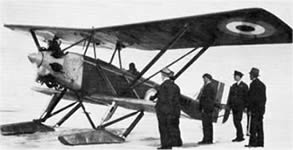The Aircraft Manufacturing Company Limited (Airco) was an early British aircraft manufacturer. Established during 1912, it grew rapidly during the First World War, referring to itself as the largest aircraft company in the world by 1918.
This is a list of aviation-related events from 1920:
This is a list of aviation-related events from 1919:

A Canadian Forces base or CFB is a military installation of the Canadian Armed Forces. For a facility to qualify as a Canadian Forces base, it must station one or more major units.

Northern Alberta Railways was a Canadian railway which served northern Alberta and northeastern British Columbia. Jointly owned by both Canadian National Railway and Canadian Pacific Railway, NAR existed as a separate company from 1929 until 1981.
Alberta Provincial Highway No. 2, commonly referred to as Highway 2 or the Queen Elizabeth II Highway, is a major highway in Alberta that stretches from the Canada–United States border through Calgary and Edmonton to Grande Prairie. Running primarily north to south for approximately 1,273 kilometres (791 mi), it is the longest and busiest highway in the province carrying more than 170,000 vehicles per day near Downtown Calgary. The Fort Macleod—Edmonton section forms a portion of the CANAMEX Corridor that links Alaska to Mexico. More than half of Alberta's 4 million residents live in the Calgary–Edmonton Corridor created by Highway 2.

RCAF Station High River was a station of the Royal Canadian Air Force (RCAF) located at High River, Alberta, Canada.

The Airco DH.4 is a British two-seat biplane day bomber of the First World War. It was designed by Geoffrey de Havilland for Airco, and was the first British two-seat light day-bomber capable of defending itself.

The Air Board was Canada's first governing body for aviation, operating from 1919 to 1923. The Canadian government established the Air Board by act of Parliament on June 6, 1919, with the purpose of controlling all flying within Canada. Canada was the first country to legislate and implement rules governing the entire domain of aviation.

Clennell Haggerston "Punch" Dickins was a pioneering Canadian aviator and bush pilot. Northern Indigenous Canadians called him "Snow Eagle", northern Europeans called him "White Eagle", while the press dubbed him the "Flying Knight of the Northland".

The Airco DH.9 – also known after 1920 as the de Havilland DH.9 – is a British single-engined biplane bomber that was developed and deployed during the First World War.

The Airco DH.9A is a British single-engined light bomber that was designed and first used shortly before the end of the First World War. It was a development of the unsuccessful Airco DH.9 bomber, featuring a strengthened structure and, crucially, replacing the under-powered and unreliable inline 6-cylinder Siddeley Puma engine of the DH.9 with the American V-12 Liberty engine.

The Airco DH.6 was a British military trainer biplane used by the Royal Flying Corps during the First World War. Known by various nicknames, including the "Clutching hand" and "Skyhook", many survived to be used as a civil light aircraft in the postwar era.

Number 55 Squadron was a flying squadron of the Royal Air Force (RAF). First formed in April 1917, the squadron saw action on the Western Front during the First World War. Based in the Middle East during the interwar period and the Second World War, No. 55 Squadron saw action over Iraq, Egypt, Libya and Italy. Between 1960 and 1993, the unit flew the Handley Page Victor. Initially on the Victor B.1A before becoming a tanker squadron in 1965 with the Victor B(K).1A/K.1/K.1A before converting to the Victor K.2 in 1975. Disbanding in October 1993, No. 55 Squadron were the last RAF unit to operate the Victor. Between 1996 and 2011, No. 55(Reserve) Squadron operated the Hawker Siddeley Dominie T.1 from RAF Cranwell, Lincolnshire, helping to train navigators for the RAF.

The Canadian Air Force (CAF) was a contingent of two Canadian air force squadrons – one fighter and one bomber – authorized by the British Air Ministry in August 1918 during the close of the First World War. The unit was independent from the Canadian Expeditionary Force and the Royal Air Force (RAF).
Mînî Thnî is a First Nations settlement within the Stoney 142/143/144 Indian reserve in southern Alberta, Canada. It is located along the Canadian Pacific Kansas City railway between the Trans-Canada Highway and the Bow River, upstream from Ghost Lake. It has an elevation of 1,240 metres (4,070 ft). The settlement is located in census division No. 15 and in the federal riding of Wild Rose. The settlement and the Indian reserve are part of the Stoney Nation.

RCAF Station Jericho Beach, originally known as the Vancouver Air Station, was one of the first Canadian air stations opened by the Canadian Air Board. Jericho Beach is located in Vancouver, British Columbia.

The Canadian Vickers Vigil was a single-seat patrol aircraft designed to meet a Royal Canadian Air Force requirement for a forest fire patrol aircraft.

The Imperial Gift was the donation of aircraft from surplus stocks in Britain after World War I to the dominions of the British Empire: Canada, Australia, New Zealand, South Africa and India. On 29 May 1919, the Cabinet of the United Kingdom agreed to give 100 aircraft to the dominions in addition to replacements for aircraft donated to Britain during the war. These aircraft formed the core of newly established air forces in several dominions.
No. 2 Squadron was a Royal Canadian Air Force (RCAF) squadron active during the late 1930s. The squadron operated army cooperation aircraft from 1935, and upon the outbreak of World War II was selected for overseas duty. However, a shortage of aircraft forced its disbandment in late 1939 to reinforce two other squadrons.














